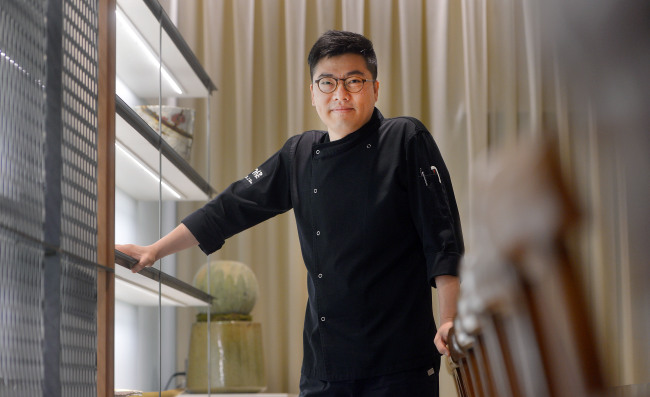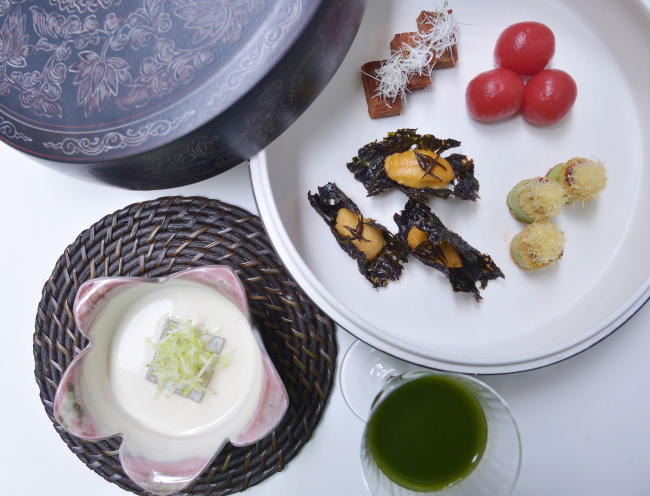[Herald Interview] Gaon’s modern take on Joseon royal cuisine
Fresh ingredients inspire Kim Byeong-jin, a master of modern Korean cuisine
By Lee Woo-youngPublished : July 14, 2016 - 14:47
The kings of the Joseon era (1392-1910) tucked into a total of seven meals daily and each one involved meticulous planning.
The day would begin with a medicinal herbal soup early in the morning, followed by breakfast, lunch and dinner with light meals and snacks between the three meals.
All the meals were carefully planned and prepared by court doctors and kitchen staff, who regarded King’s food as an important part of national politics in the kingdom, which existed more than 500 years before Korea came under Japanese rule.
The Joseon era’s royal cuisine still proves relevant these days, this time, for the masses. Kim Byeong-jin, the executive chef at Gaon, finds that the yesteryear cuisine can bring nutritional and health benefits for present-day Koreans who are under constant stress from hectic lifestyles.
“Healthy meals are the focus of many modern Koreans when they choose what to eat. I thought the Joseon era’s royal meal plans would be a good reference,” said Kim in an interview on July 6 at the Korean restaurant Gaon at Horim Art Center, Gangnam, Seoul.
The day would begin with a medicinal herbal soup early in the morning, followed by breakfast, lunch and dinner with light meals and snacks between the three meals.
All the meals were carefully planned and prepared by court doctors and kitchen staff, who regarded King’s food as an important part of national politics in the kingdom, which existed more than 500 years before Korea came under Japanese rule.
The Joseon era’s royal cuisine still proves relevant these days, this time, for the masses. Kim Byeong-jin, the executive chef at Gaon, finds that the yesteryear cuisine can bring nutritional and health benefits for present-day Koreans who are under constant stress from hectic lifestyles.
“Healthy meals are the focus of many modern Koreans when they choose what to eat. I thought the Joseon era’s royal meal plans would be a good reference,” said Kim in an interview on July 6 at the Korean restaurant Gaon at Horim Art Center, Gangnam, Seoul.

“Gaon’s course menus restage the order of a Joseon king’s daily meal,” he added.
The restaurant’s summer menu begins with a light and slightly sweet, green extract made with minari, or water dropwort, apple, lemon and the local sinseoncho herb. The first dish is meant to stimulate your appetite and provide energy.
“A king had a medicinal decoction when he woke up in the morning. It was to give him full energy to start the day,” Kim explained.
It is served with an entree dish of seasonal ingredients that spans the five tastes -- sweetness, saltiness, sourness, bitterness and spiciness.
“This is where modern cooking techniques are applied to draw out the natural flavors from each ingredient,” he said.
Serving Korean food as a multi-course meal was rare until 2003 when Gaon first tried preparing dishes in courses. In a typical Korean meal, the dishes are presented all at once and shared by everyone.
However, it wasn’t the formal way Koreans had their meals. For more than 500 years during the Joseon era, each person received a separate table of food, Kim explained. Kim, with 21 years of experience in Korean cooking, joined Gaon in 2003.
“In modern-day Korean, having as many dishes as possible on the table was a symbol of one’s social status until recently,” said Kim.

Gaon offers two multi-course menus: the nine-course “Onnal,” which highlights ingredients’ flavors enhanced by the chef’s cooking techniques and the 10-course “Gaon,” which combines traditional cooking methods and chefs’ creativity.
“We want to set a certain standard in modern Korean cuisine,” said Kim.
Red ginseng chicken soup, one of the restaurant’s signature dishes, called “hongyetang,” is included in the summer menu. Unlike the popular samgyetang made with chicken and white ginseng, Gaon’s hongyetang is made with black-skinned Silkie chicken and red ginseng that results in a richly flavored, thick broth.
Kim finds inspiration in fresh ingredients when he draws up seasonal course menus.
For example, he travels to different chicken farms to look for the right breed of chicken that has a certain flavor that he wants to deliver to his guests. Once he selects the right ingredient, he studies several old recipe books, including the 17th century cookbook “Eumsik Dimibang,” for reference and incorporates modern-cooking techniques.
“Without the ingredients, there is no creativity,” he noted. “And we don’t make any compromises on the quality of ingredients.”
The main menu in the summer course consists of rice, soup and side dishes. Freshness abounds in sea urchin roe and chive salad on top of rice that is eaten mixed with a laver sauce made with ground laver and soy sauce infused with a marinated raw crab.
Kim plans his seasonal course menus three months ahead. The preparation period involves numerous visits to local markets, experiments with different cooking techniques to deliver honest flavors and practice with his kitchen staff of six for consistency in quality.
Kim likes to travel to local markets in the provinces, especially those on the western and southern coasts of Korea. “They are home to so many fresh ingredients,” said Kim.
“I have deep trust in fresh ingredients because they set the standard of food and guarantee quality from the beginning to the end of the course,” Kim said.
By Lee Woo-young (wylee@heraldcorp.com)





![[From the Scene] Monks, Buddhists hail return of remains of Buddhas](http://res.heraldm.com/phpwas/restmb_idxmake.php?idx=644&simg=/content/image/2024/04/19/20240419050617_0.jpg&u=20240419175937)





![[Graphic News] French bulldog most popular breed in US, Maltese most popular in Korea](http://res.heraldm.com/phpwas/restmb_idxmake.php?idx=644&simg=/content/image/2024/04/18/20240418050864_0.gif&u=)


![[From the Scene] Monks, Buddhists hail return of remains of Buddhas](http://res.heraldm.com/phpwas/restmb_idxmake.php?idx=652&simg=/content/image/2024/04/19/20240419050617_0.jpg&u=20240419175937)

![[KH Explains] Hyundai's full hybrid edge to pay off amid slow transition to pure EVs](http://res.heraldm.com/phpwas/restmb_idxmake.php?idx=652&simg=/content/image/2024/04/18/20240418050645_0.jpg&u=20240419100350)

![[Today’s K-pop] Illit drops debut single remix](http://res.heraldm.com/phpwas/restmb_idxmake.php?idx=642&simg=/content/image/2024/04/19/20240419050612_0.jpg&u=)